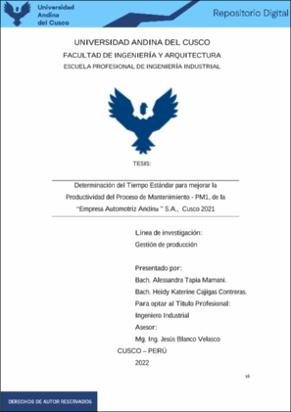| dc.contributor.advisor | Blanco Velasco, Jesús Raúl | |
| dc.contributor.author | Tapia Mamani, Alessandra | |
| dc.contributor.author | Cajigas Contreras, Heidy Katerine | |
| dc.date.accessioned | 2023-03-27T22:03:36Z | |
| dc.date.available | 2023-03-27T22:03:36Z | |
| dc.date.issued | 2022-10-21 | |
| dc.identifier.uri | https://hdl.handle.net/20.500.12557/5251 | |
| dc.description.abstract | La presente investigación tiene por objetivo principal determinar en que medida el
Tiempo Estándar mejora la productividad del proceso de mantenimiento PM1, de la
“Empresa Automotriz Andina.” S.A, siguiendo una metodología de enfoque
cuantitativo (tipo aplicada, nivel descriptiva y de diseño pre-experimental).
Se utilizaron las técnicas de la observación directa y un análisis documental,
aplicandose a una población de 20 trabajadores del área de mantenimiento de la “Empresa
Automotriz Andina” S.A. y como resultado se obtuvo que el tiempo estándar inicial fue de
257 min por servicio PM1, con una capacidad de eficiencia enfocada al 55.91%, la eficacia
se porcetualizo al 61.78% y la productividad inicial fue del 34.56%.
Para lograr el objetivo principal de mejorar la productividad, se procedio con la
aplicación de un plan de mejora que consta de los siguientes: análisis de las actividades del
proceso de mantenimiento, diagrama de recorrido, determinación del Tiempo Estándar
nuevo, diagrama de operaciones y diagrama de análisis de procesos. Desde el punto de vista
de cuadros comparativos de ambos procesos se obtuvo, que el Tiempo Estándar disminuyó
a 170.8 min por servicio PM1, la eficiencia a 69.32%, la eficacia a 93.75% y la productividad
final a 65.03%,
En conclusión según el análisis realizado existe un incremento de 30.48% en la
productividad, lo cual indica que la hipótesis de la determinación del Tiempo Estandar
mejoró la productividad del proceso de mantenimiento PM1, de la “Empresa Automotriz
Andina S.A.” | es_PE |
| dc.description.abstract | The main objective of this research is to determine to what extent the standard time
improves the productivity of the PM1 maintenance process, of the company “Autrisa
Automotriz Andina.” S.A, following a quantitative approach methodology (applied type,
descriptive level and preliminary design -experimental). The techniques of direct
observation and documentary analysis were used, applied to a population of 20 workers in
the maintenance area of the company “Autrisa Automotriz Andina”S.A., and as a result it
was obtained that the initial standard time was 257 min per service. PM1, with an efficiency
capacity focused on 55.91%, the efficiency was percentaged at 61.78% and the initial
productivity was 34.56%.
To achieve the main objective of improving productivity, we proceeded with the
application of an improvement plan consisting of the following: analysis of the activities of
the maintenance process, route diagram, determination of the new standard time, operations
diagram and diagram process analysis. From the point of view of comparative tables of both
processes, it was obtained that the standard time decreased to 170.8 min per PM1 service,
the efficiency to 69.32%, the effectiveness to 93.75% and the final productivity to 65.03%.
In conclusion, according to the analysis carried out, there is an increase of 30.48% in
productivity, which indicates that the hypothesis of the determination of the standard time
improved the productivity of the maintenance process PM1, of the automotive company
"Andina S.A." | en_US |
| dc.format | application/pdf | es_PE |
| dc.language.iso | spa | es_PE |
| dc.publisher | Universidad Andina del Cusco | es_PE |
| dc.rights | info:eu-repo/semantics/openAccess | es_PE |
| dc.rights.uri | https://creativecommons.org/licenses/by-nc-nd/4.0/ | es_PE |
| dc.subject | Mantenimiento | es_PE |
| dc.subject | Productividad | es_PE |
| dc.subject | Tiempo estándar | es_PE |
| dc.title | Determinación del tiempo estándar para mejorar la productividad del proceso de mantenimiento - PM1, de la “Empresa Automotriz Andina ” S.A., Cusco 2021 | es_PE |
| dc.type | info:eu-repo/semantics/bachelorThesis | es_PE |
| thesis.degree.name | Ingeniero Industrial | es_PE |
| thesis.degree.grantor | Universidad Andina del Cusco. Facultad de Ingeniería y Arquitectura | es_PE |
| thesis.degree.discipline | Ingeniería Industrial | es_PE |
| dc.publisher.country | PE | es_PE |
| dc.subject.ocde | https://purl.org/pe-repo/ocde/ford#2.11.04 | es_PE |
| renati.advisor.dni | 23950405 | |
| renati.advisor.orcid | https://orcid.org/0000-0002-4608-4196 | es_PE |
| renati.author.dni | 70002615 | |
| renati.author.dni | 72947670 | |
| renati.discipline | 722026 | es_PE |
| renati.juror | Benavides Palomino, Carlos Alberto | |
| renati.juror | Rojas Marroquin, Anghela Natassia | |
| renati.juror | Chuquimia Hurtado, Arturo | |
| renati.juror | Muñoz Camero, Rocío | |
| renati.level | https://purl.org/pe-repo/renati/level#tituloProfesional | es_PE |
| renati.type | https://purl.org/pe-repo/renati/type#tesis | es_PE |
| dc.description.lineadeinvestigacion | Gestión de producción | es_PE |


